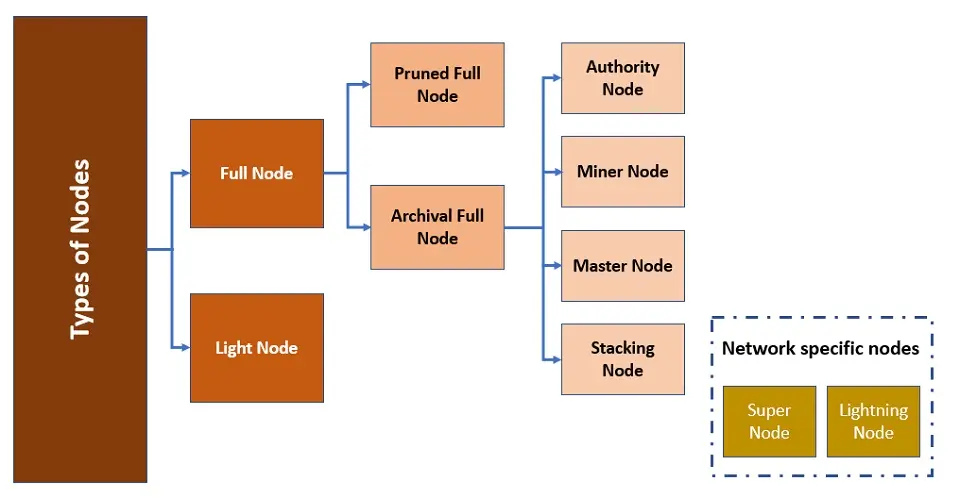Nodes for Integrity and Credibility in Blockchain

Blockchain is the combination of a decentralized and distributed database, or in non-technical terms, a distributed ledger containing a registry of transactions distributed among peers or fellow participants in the network. The blocks of the blockchain, which are not physical entities, contain this transaction.
What are Nodes in a Blockchain?
Let’s take a practical example of the accounting department in a company. There are transactions, and there are ledgers to record those transactions. But who exactly is responsible for maintaining the ledger? The accountants, right?
You can relate the nodes with the accountants who maintain the ledger and ensure decentralization in the network. Apart from the Key Technologies behind blockchain, nodes are fundamental parts of the blockchain.
Nodes in Technical Terms
Nodes are electronic devices connected to the network with an address in the digital work (IP address). Every node in the blockchain has a copy of the shared ledger.
Nodes are needed to ensure the network’s decentralization and that no one in the network is cheating in terms of double spending or reversing the blockchain transaction. Furthermore, they ensure that every transaction in the network is genuine by ensuring the consensus without any central authority.
Please note that not every user interacting with the blockchain network is called a node. In simple terms, every electronic device connected to the network is not called a node. Additionally, all nodes do not provide the same functionality.
Types of Nodes
Nodes are classified based on the role they are responsible for playing in the blockchain network. The reason is to seamlessly operate the network where different nodes are responsible for completing different tasks.
NOTE: It is important to note that the type of nodes and their role is defined as a requirement in the blockchain network. Therefore, in different blockchains such as Hyperledger Fabric, bitcoin, etc., the role and responsibilities of nodes may vary.
As stated above, the type of nodes in the blockchain depends on the network. However, there are two prominent node types, which are as follows:
- Full nodes
- Light nodes
Full nodes
When hosting a webpage, we get results from the server nearest to our location. Similarly, in blockchain, some nodes maintain or store the details of all the blocks in the network. Hence, when we request information, it comes from the node nearest to the requested location.
Full nodes also enjoy the governance privilege. The full nodes have the voting power when there is any need for upgrades or improvements in the blockchain network.
Full nodes enjoy the privilege of making decisions about the future of the network by voting. If more than 51% of nodes disagree, the decision gets skipped. Sometimes, hard-forking occurs when the community cannot agree on the decision. Therefore, a split takes place, causing the creation of two separate blockchains— for example, a Bitcoin cash fork.
The main task of a full node is to maintain the consensus in the blockchain and verify the transaction.
Full nodes are further classified into two different types:
- Pruned Full nodes
- Archival Full nodes
Let’s discuss them and understand how they vary from each other.
Pruned Full nodes
Such nodes can hold the data to a specifically defined limit. There is no limit to how many blocks can be added. However, the limitation depends on the memory space.
Pruned Full nodes download the new blocks created, and when it reaches the memory limit, it deletes the oldest block to store the new block created. The old blocks are not fully deleted, and the metadata of such blocks is still stored to maintain the principles of blockchain.
Archival Full nodes
Archival Full nodes are common full nodes in the blockchain. They maintain a full blockchain without any limits. This is the only difference between the pruned and archival full nodes. Such nodes are further classified into four types based on the criteria of nodes that can add a block to the blockchain and those that cannot. These four types of nodes are as follows:
- Authority nodes
- Miner nodes
- Master nodes
- Staking nodes
Let’s understand the different functions such nodes have to offer.
Authority nodes
In a public blockchain, anyone can join the network and access the data available in the network. In such cases, there must be governance, which is why there is a need for authority nodes. Its responsibility is to check the authority of other nodes who want to join the network.
The responsibility of the authority node may vary from network to network. For example, in some networks, the authority node can also be responsible for defining the node’s role who wishes to join the network, creating, validating blocks, and distributing information to users in the network.
Miner nodes
They create the blocks in the network using defined consensus algorithms such as Proof-of-Work or Proof-of-Stake, etc. Finally, the miner node takes the unconfirmed transactions in the mining pool and creates a block. For example, the first person to complete the cryptographic problem broadcasts its results in the Bitcoin network and gets flooded across the network using the gossip protocol.
The full nodes verify the block, and after verification, the right is granted to add a block to the blockchain. Moreover, the person is rewarded with an amount called Coinbase or a “Coinbase transaction”, the first transaction of any block.
Staking nodes
Like miner nodes, these nodes are responsible for validating the transaction. For example, in the Proof-of-Stake consensus algorithm, such nodes stake their crypto coins to validate the transaction and ultimately get a reward in crypto coins.
In stacking, the selection of the nodes is based on pre-defined rules by the network. Such rules include the time spent in-network or the age of the coin (how long you had your coins) and luck chances. These nodes don’t need high computation power but require the 24/7 availability of crypto wallets. For example, we can use Raspberry Pi to achieve the high availability of crypto wallets.
Master nodes
Such nodes don’t have access to create a block in the blockchain but are responsible for maintaining the blockchain ledger and validating the transactions. This is the only type of full archival node which doesn’t have access to create the block.
Light or SPV nodes
Remember the example of hosting we discussed in the full nodes? It may happen that servers nearest my location only hold the popular requested pages and don’t hold all the data. Similarly, light nodes are nodes that store only the partial details of the blocks in the network, for example, only the block’s header. Such nodes are also called Simplified Payment Verification (SPV) nodes.
The primary purpose of having light nodes is to validate the transactions without having computationally intensive machines. The light nodes store the block headers and can validate whether a transaction is present in a block or not, and they rely on full nodes for the necessary information. They don’t have the entire blockchain data and use Merkel Root to conclude a transaction.
Those mentioned above are the most prominent nodes that we should be aware of. However, few nodes are specific to the networks. Some of these are:
Super Nodes
We can think of Super Nodes as super admin users in the application. In a few blockchains, super-nodes ensure the rules defined are followed in the network.
Lightning nodes
Commonly, queuing up for the transactions in a blockchain causes a delay in processing the transactions. Lightning nodes help resolve this issue by creating a new network with the user and then pushing the transaction to the main blockchain network. In this way, the load in the main network is controlled, and transactions are processed faster.
Summary
Every blockchain enthusiast must understand the role of the blockchain. It will help design the blockchain network efficiently and improve resource, cost, and infrastructure outcomes.
Nodes are equally crucial as consensus algorithms or cryptographic techniques in any blockchain. Deciding the types of nodes and their roles as requirements carefully is crucial while designing the blockchain network.
Anyone can set up any node in the public blockchain network, as it is decentralized. If you wish to set up a node, you need to choose a blockchain, acquire the necessary hardware and software to run the node in the selected blockchain, and start running the node.

Tavish lives in Hyderabad, India, and works as a result-oriented data scientist specializing in improving the major key performance business indicators.
He understands how data can be used for business excellence and is a focused learner who enjoys sharing knowledge.

